THE “MUST-READ” MOTOCROSS ACTION 2022 125 TWO-STROKE SHOOTOUT
JAPAN’S LONE HORSE VERSUS AUSTRIA’S TRIO OF HORSES
In a world full of smartphones, smart TVs, smart cars and virtual-reality programs, we strive to get away from the hustle and bustle of the internet by spending much-needed time at the track. Even there, four-strokes, with their computer-programmed ECU mapping and Wi-Fi tuning, are more digital than ever. Don’t get us wrong, we drool over the latest dirt bike technology (at least the stuff that works). We love racing four-strokes, and we’re thankful for fuel injection and electric starting, but there’s something beautiful about a simple two-stroke engine that brings a smile to every MXA test rider’s face. The fun-to-use powerbands, lightweight handling and distinct two-stroke melody light a fire that makes us forget about looming electric bikes, Zoom meetings and virtual-reality programs.
We had a blast conducting last year’s “2021 125 Shootout,” so when Yamaha introduced a brand-new YZ125 for 2022, it was imperative that we schedule the bikes for a rematch. Unfortunately, we couldn’t get a 2022 TM 125MX because of COVID-related issues in Holland. Of course, we would have gotten our hands on a Fantic 125XX, but their agreement to platform-share Yamaha’s frame and engine forbids them from importing bikes to the USA.
Starting things off, we have to address the obvious. Only one of these bikes has received an all-new engine with an updated chassis, while the other three are unchanged from last year. Those three share identical engines and frames (with different suspension settings, airbox configurations, seat heights and triple clamps).
Ever since Honda, Suzuki and Kawasaki defected from the two-stroke fold, the 125 class has been a Yamaha-versus-KTM battle; however, for 2022, KTM has three different horses in the race. It’s not as set in stone as it would seem, because even though KTM, Husqvarna and GasGas share core components, they don’t all work the same. Surprisingly, the differences are greater than we ever imagined (as proven in our lap-time comparisons for both Pro and Novice test riders). You can make all the “White KTM” and “Red KTM” jokes you want, but the KTM group is keeping the 125 two-stroke class vibrant by increasing a 125 rider’s options—you don’t have to buy one, but thank your stars that one company cares enough to invest in offering three different 125 motocross bikes.
Although it placed fourth out of five last year, the new Yamaha YZ125 has some serious momentum coming into the “2022 MXA 125 Shootout.” Every rider knows that the Yamaha YZ125 has stayed basically the same since 2006. With Honda, Kawasaki and Suzuki discontinuing their smokers, Yamaha was able to continue selling the same model year after year, because it was extremely fun to ride, affordable and easy to maintain. Plus, with KTM as its only true competition, Yamaha didn’t need to worry, as the YZ125’s passionate demographic hated the idea of owning a KTM.
A few years after the 2006 YZ125 was introduced, MXA started to complain that Yamaha wasn’t making any updates to the YZ125. For 10 years we complained religiously about the lack of any YZ125 improvements and, finally, we came to the understanding that Yamaha wasn’t going to make an all-new YZ125. So, we stopped complaining and became thankful that at least Yamaha was still producing two-strokes. After we were lulled into the YZ125 doldrums for 16 straight years, Yamaha came out with a shiny new Yamaha YZ125. Was it all we ever wished for? No! But it was more than we expected.
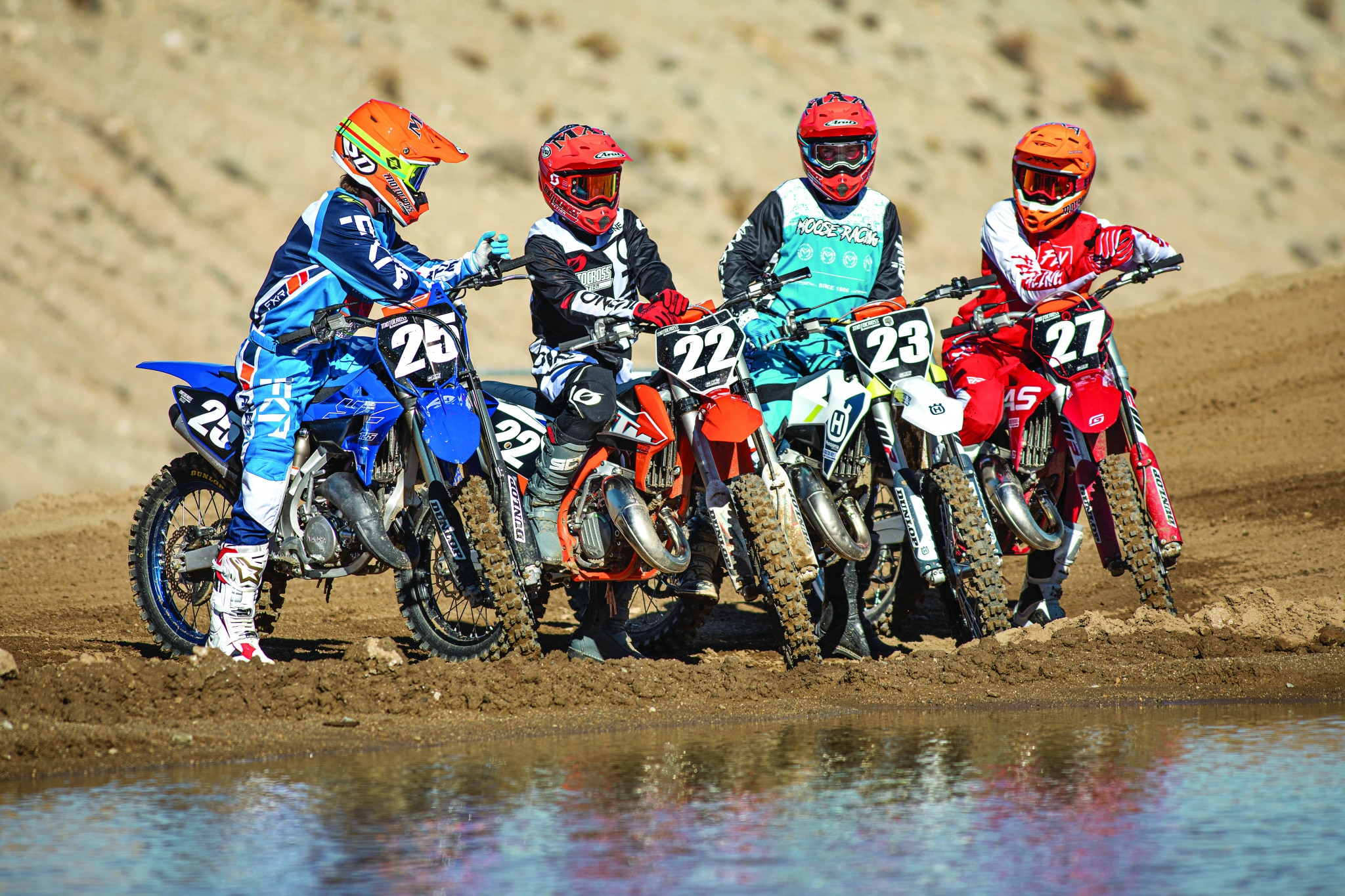
WHAT’S NEW FOR 2022?
So, what changed on the Yamaha? First, let’s go over a little history. Yamaha made major updates to the 2005 YZ125 when they came out with an all-new engine. It was radically changed from the previous 2004 engine, as was the new aluminum frame that replaced their previous steel frame. In 2006, Yamaha brought out the brilliant Kayaba SSS (Speed Sensitive Suspension) forks that have been a huge hit ever since. MXA has loved the chassis and suspension on this bike for years, and many of our test riders have called the YZ125 the most fun bike to ride straight off the showroom floor. The YZ125 didn’t sit stagnant over the ensuing years; it often got hand-me-downs from Yamaha’s four-stroke line, most notably brakes, footpegs, brake rotors, arrow plastic, silencers, main jets and rim color.
In 2022, Yamaha kept the same frame, made some minor updates to the KYB SSS forks and kept the same triple clamps, swingarm and linkage so that the handling is very similar. As for the rest of the bike, it got some serious changes. Nearly every functional part of the engine is new—the cylinder body, cylinder head, cylinder port shape, cylinder port timing, piston, piston pin, connecting rod, crankcase, crankshaft, flywheel, transmission, shift shaft, reed valve and power valve, as well as the pipe and silencer. The YZ125 also has a new rear fender, side number panels, subframe, seat base and air-filter cage to flow more air into the engine from underneath the back of the seat. Plus, it comes with a Keihin PWK-S38 carburetor now instead of the 38mm Mikuni TMX. Besides the front fender, front number plate and fork guards, all of the plastics have been updated, and it has a new fuel tank, new radiator louvers, new seat and new airbox. Additionally, it has updated brakes from the YZ-F models, Bridgestone Battlecross X20 tires, a new chain and rear sprocket.
As for Yamaha’s 125cc competition, the KTM, Husqvarna and GasGas bikes are basically the same for 2022. The updates for KTM are limited to new graphics and an orange frame. The Husqvarna has updated graphics with Brembo clutch actuation instead of Magura, and the GasGas is exactly the same as it was when it first came out last season.
As usual, our shootout results come after gathering opinions from a wide range of testers riding each bike in its stock form, back to back against the competition. Every rider is entitled to his own opinion about how each bike works, but the beauty of Motocross Action is that we have these bikes in our garage for a full year, and we have the resources and ability to ride them all on the same day, doing true-to-life comparisons as often as we want. It’s easy for us to relate to people who think the KTM/Husky/GasGas bikes work the same on the track, because, frankly, it can be difficult to tell the difference if you don’t eliminate the variables. We spend long hours at the track doing lap-time comparisons and ensuring each bike is taken care of equally. It’s a tough job, but someone has to do it.
SHOOTOUT WITHIN A SHOOTOUT:
We had a blast shaking down these 125 two-strokes, and many of our testers were surprised by the lap-time differences they experienced between the Austrian brands. In this section, we have a mini shootout-within-a-shootout, explaining the pros and cons of the orange, white and red smokers before putting them up against the brand-new Yamaha.
There are nine categories that cover horsepower by brand at 6000 rpm all the way of 12,000 rpm, plus peak horsepower and torque. The blue boxes signify the bikes that are the best in that rpm range. The light blue boxes show the bikes that are the worst in each category.
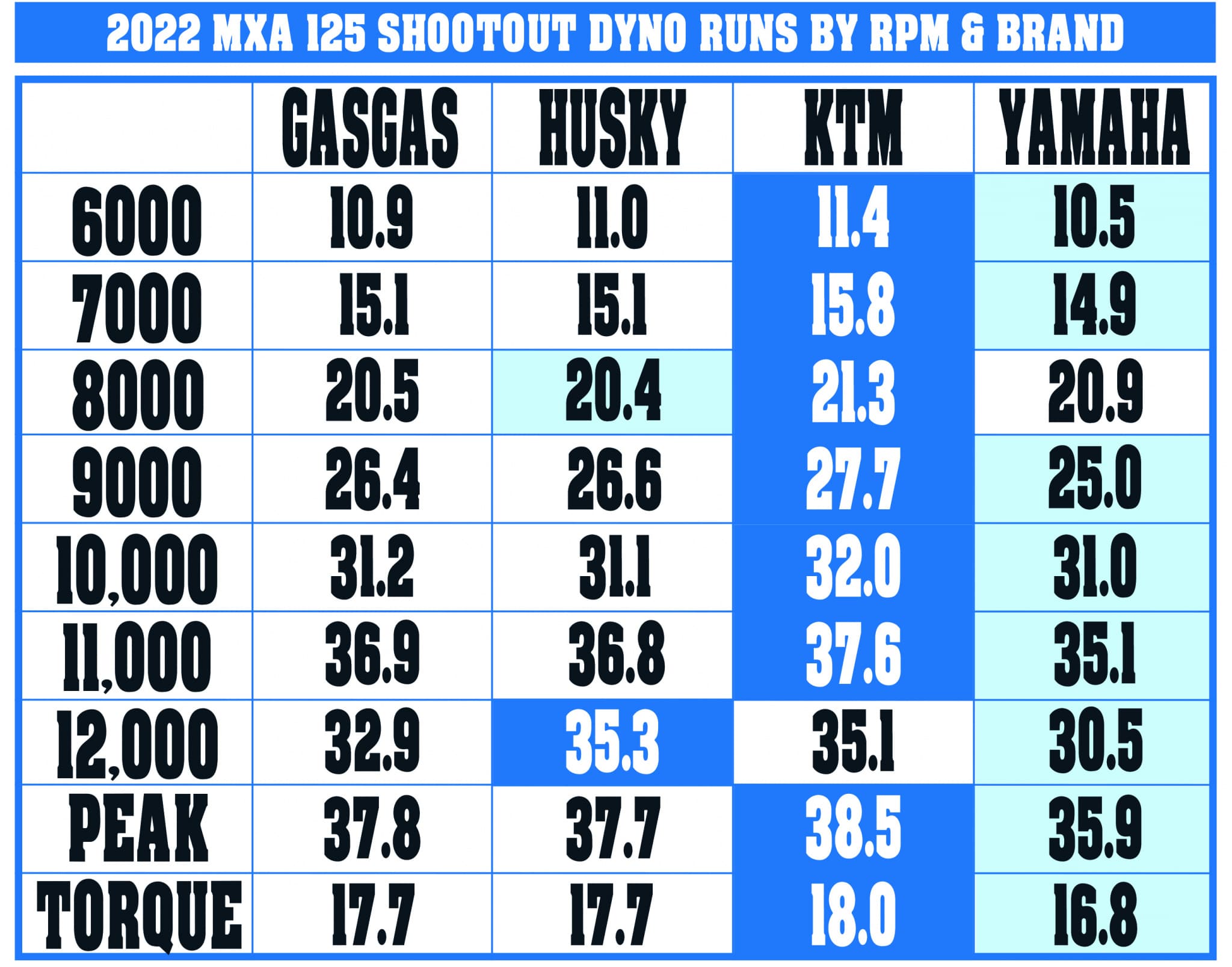
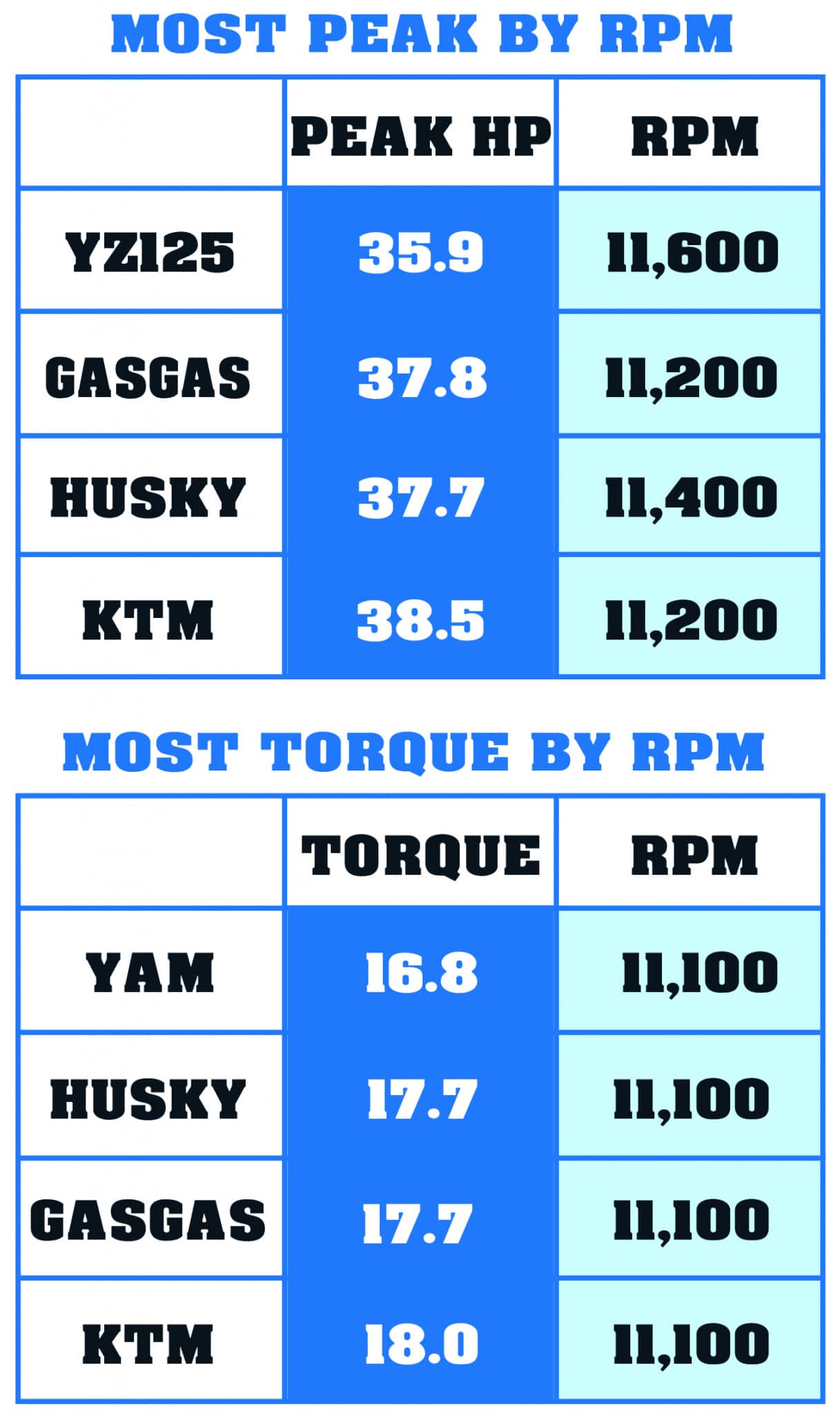
PEAK 125 HORSEPOWER BY RPM
Peak horsepower is the single-most talked-about number and, paradoxically, one of the least important numbers to pay attention to; however, if you look at peak horsepower and where on the rpm curve it is reached, it does give you a clue as to where the apex of a bike’s powerband lies (from most horsepower to least). Here is how the 125cc two-strokes stack up against each other.
Yamaha YZ125: 35.9 (11,600 rpm)
GasGas MC 125: 37.8 (11,200 rpm)
KTM 125SX: 38.5 (11,200 rpm)
Husky TC125: 37.7 (11,200 rpm)
WHAT THE 2022 125s WEIGH
These are the actual weights of the current crop of 2022 125 motocross bikes (lightest to heaviest). They have been weighed on the same calibrated balance-beam scale under the official AMA and FIM system of empty gas tanks but all other fluids.
GasGas MC 125: 194
KTM 125SX: 194
Husky TC125: 195
Yamaha YZ125: 199
WHAT THE 2022 125s COST
These are the Manufacturers’ Suggested Retail Prices (MSRPs) for all four 2022 125s (least to most expensive). Your local dealer is free to lower or raise the price of the bikes on their showroom floor. The price in the USA is determined by the exchange rate of the euro for European bikes and the yen for Japanese bikes.
GasGas MC 125: $6899
Yamaha YZ125: $6899
KTM 125SX: $7499
Husky TC125: $7599
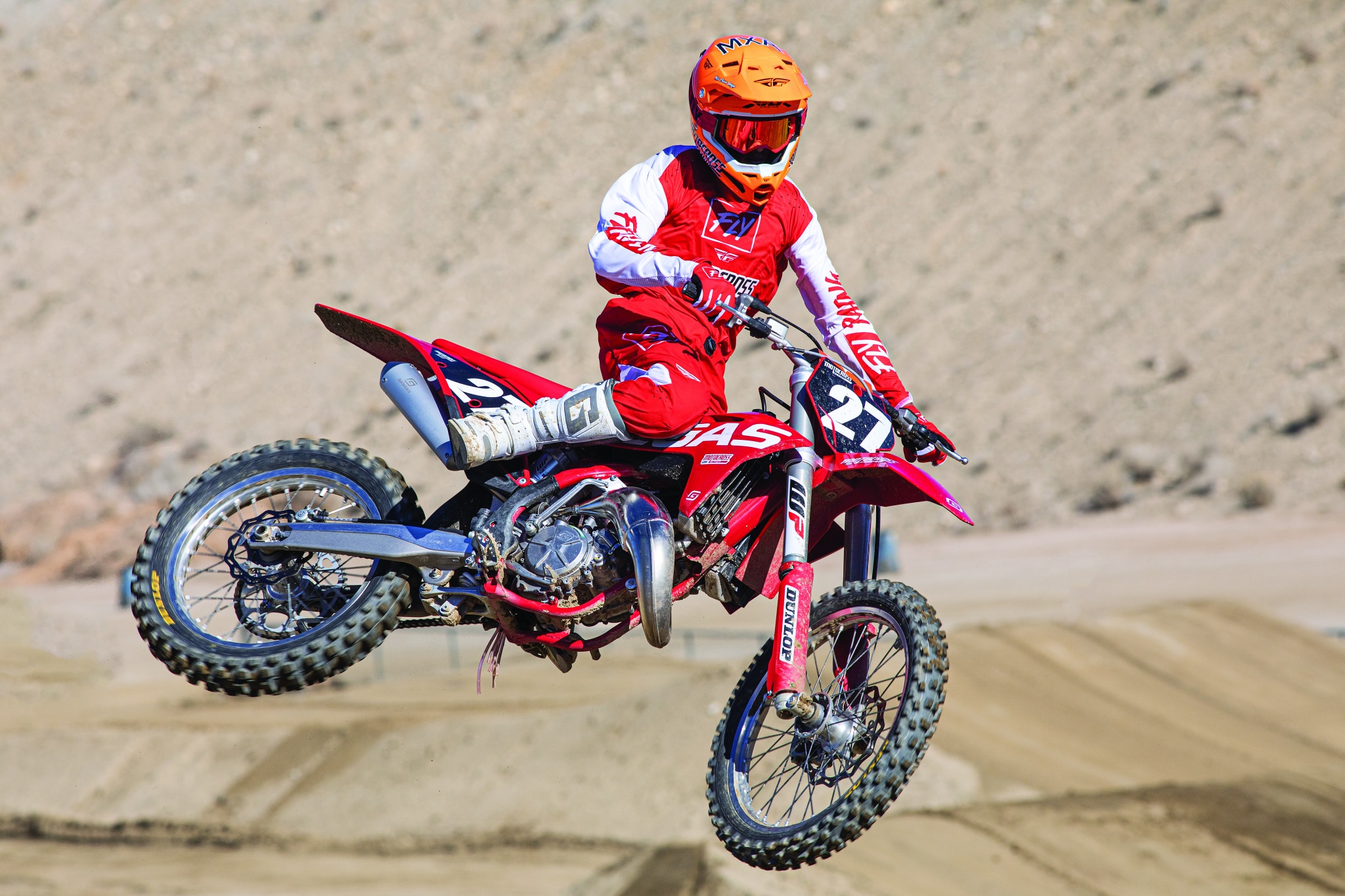
2022 GASGAS MC 125
The Spanish-made GasGas brand was bought by the KTM Group, moved to Austria and integrated into the KTM platform-sharing model with a price point targeted at stealing customers away from Yamaha. Retailing for $6899, it’s the same price as the new YZ with the identical engine, carburetor, frame, subframe, brakes, swingarm and suspension as the KTM. Plus, the GasGas wins best-looking bike in the class with its cherry-red steel frame and plastics and shiny silver rims that match the triple clamps and handlebars perfectly. The noticeable differences between the GasGas and KTM are the forged-aluminum triple clamps, closed-off airbox cover, and the softer suspension settings. With these parts, GasGas has targeted an audience that’s more focused on fun than winning races. Generally, GasGas buyers can be split into two categories. First, riders who like the idea of softer and plusher suspension, enhanced by the flex of the forged-aluminum triple clamps (even if they feel vague at corner entrance). Second, riders who plan to send the GasGas suspension components off to be sprung and valved specifically for their needs (with billet triple clamps as part of the updates, basically turning the GasGas MC 125 into a KTM 125SX).
Comparing the GasGas to the Husky on the track, it is surprisingly faster coming out of turns, making it easier to get into the meat of the power and better for experienced riders who want to go fast. GasGas scores above Husky and below KTM on power delivery because the shape of the airbox is better for flowing air than the Husky’s, but the cover is more closed off than on the KTM. As for the handling, the GasGas is softer and more comfortable for novice riders but too soft for serious racers.
The GasGas MC 125 retails for $600 less than the KTM, $700 less than the Husky, and it is actually a better racer than the Husky for experienced riders.
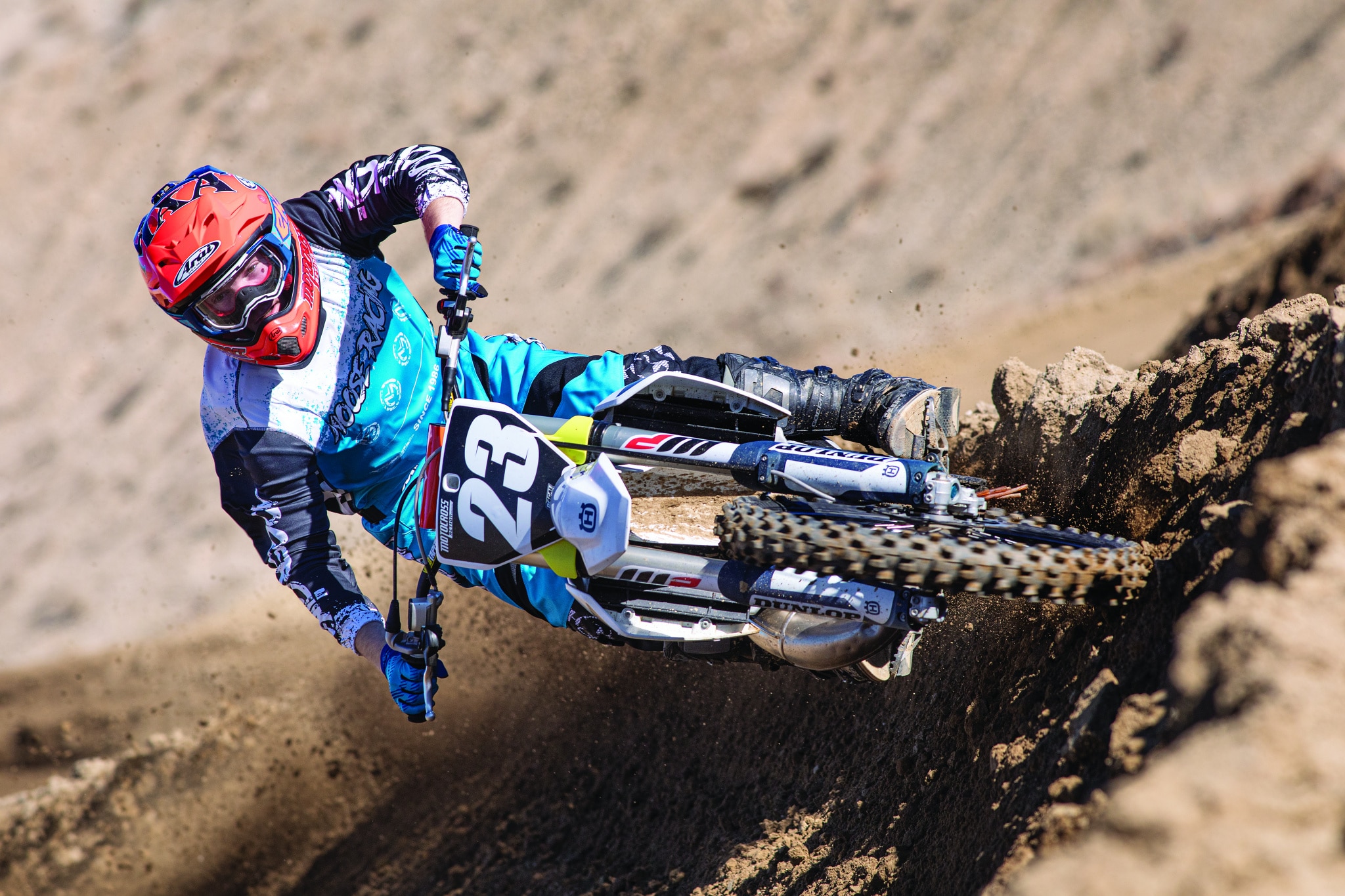
2022 HUSQVARNA TC125
Husqvarna has been under the KTM umbrella since 2014. Before that, the Husky 125 was made in Italy with typically odd Italian flare. Husky has steadily upped its “style game” thanks to the designers at Kiska who are the official design department for all of the Austrian brands.
The first difference between the $7599 Husqvarna and the KTM is its noticeably lowered suspension platform. Husky threw a Hail Mary in 2021 when they shortened their forks by 10mm, lengthened the seal head on the shock, lengthened the shock linkages and adjusted the rising-rate linkage geometry to lower the rear end approximately an inch at the seat. A bonus on the Husky is that it is slightly wider at the rear end, which some riders believe makes the Husky easier to grip with their legs. One downside of the Husqvarna design package is the carbon/plastic composite subframe that has a differently shaped airbox and full-length airbox cover that is blamed for detuning the throttle response. The muted throttle response and slower-revving power are noticeable on the FC450, but the sensation is magnified on 250 four-strokes and 125 two-strokes. Compared to the KTM and GasGas, the Husky is harder to get into the powerband, meaning it’s easier to bog on the corner exit of tight turns, and it’s not as responsive at the crack of the throttle. The silver lining to the 2022 Husqvarna is that every MXA test rider preferred the lower suspension of the Husky over the KTM and GasGas. The Husky tracks through ruts with unerring accuracy and is incredibly nimble everywhere. The lower center of gravity is something we cherish.
As for the real nuts and bolts, the Husqvarna is better for novice riders than it is for pro riders. In lap-time comparisons, pro riders were as much as two seconds slower on the Husky than they were on the KTM, while the lap times for our Novice test riders were the opposite; they were actually a full second faster on the Husky than they were on the GasGas, which is traditionally a favorite of vet and novice testers.
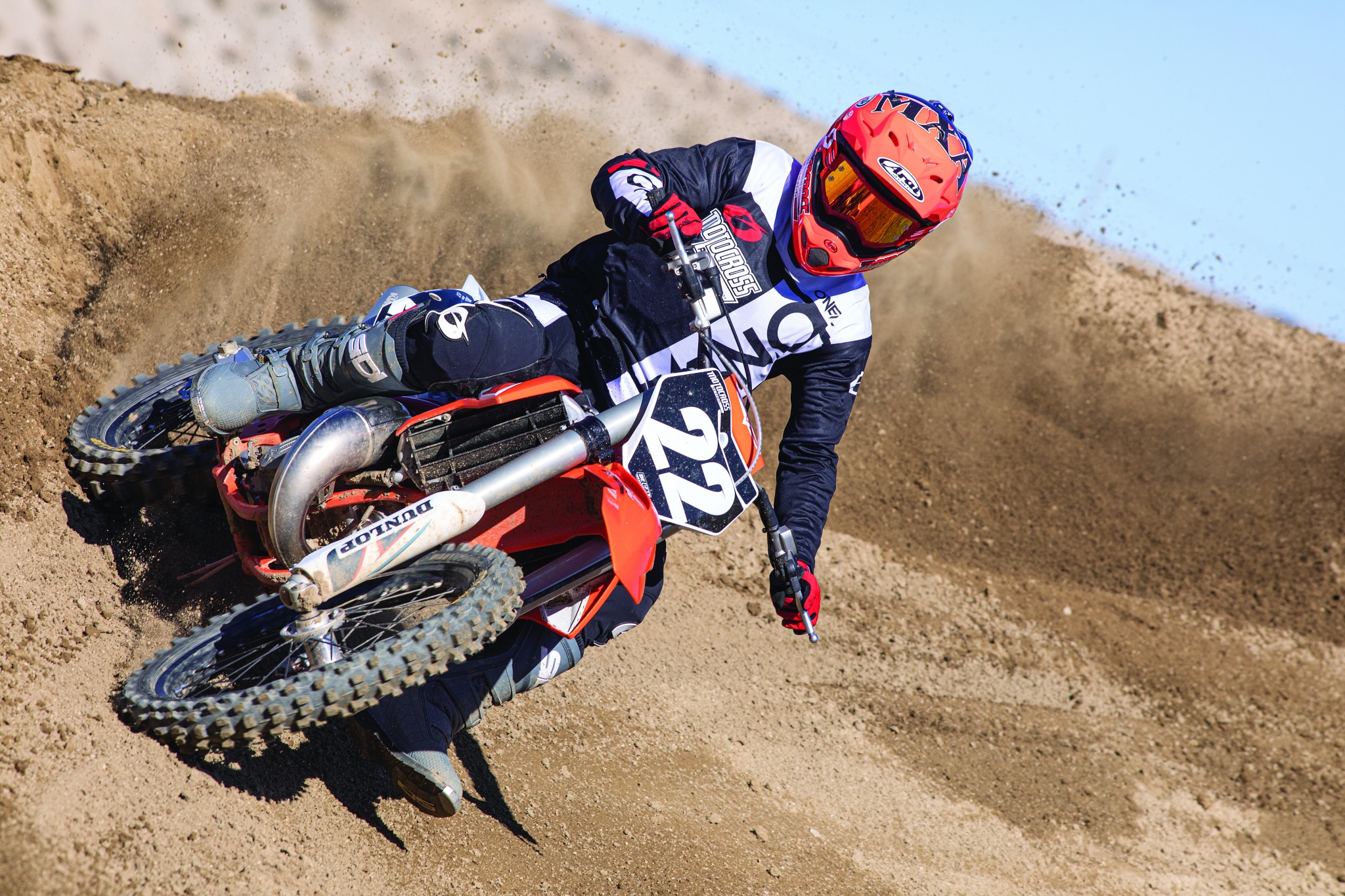
2022 KTM 125SX
At $7499, the “Ready to Race” tagline rings true for the KTM 125SX. Weighing in at 194 pounds, the KTM has the raciest suspension settings with stiffer valving than the GasGas or Husky offerings. It also has an airbox that breathes better than its two stablemates’, giving it the snappiest throttle response and power. Engines are air pumps; they add fuel and spark to turn air into horsepower. If an engine is suffocated, power is reduced. The smallest differences in power are magnified when you’re riding stock two-strokes in the sub-40-horsepower range. In this class, slight modifications make for significant improvements. The KTM 125SX picks up and goes with a powerband that is ultra fun to ride.
For serious riders, the KTM’s stiffer suspension setup can handle higher speeds as well as bigger jumps. All of the Austrian 125s feature the WP XACT air forks that received major improvements in 2021. It is also important to note that the KTM, Husky and GasGas roll off the assembly lines with parts that the Yamaha is missing: (1) A counterbalancer to reduce vibration in the engine. (2) Braided steel hoses. (3) Hydraulic clutch actuation. (4) A steel clutch basket with the primary gear CNC-machined in. (5) 260mm Brembo brakes front and rear. (6) Wheel spacers that ride on the bearings instead of the axles (allowing owners to use aftermarket wheels even if the axles are different diameters and even if the axle size changes from year-to-year. (7) ODI lock-on grips. (8) Super convenient no-tools airbox with a Twin Air filter. (9) CNC-machined billet triple clamps (Husqvarna and KTM only). (10) Hour meter (Husqvarna and KTM only) and rubber grommets to hold the kill switch wire on the handlebars. (11) Adjustable Power Valve settings. (12) Ultra-long rear-axle slots. (13) Gunnar Gasser-style throttle.
Out of the three different Austrian bikes, the KTM is the best for the racer because it’s faster and holds up stronger. The Husky is best for the beginner, novice and vet rider because it’s lower, ultra nimble and has a smooth power output. The GasGas is best for the rider who wants to save a few bucks and stand out from the crowd.
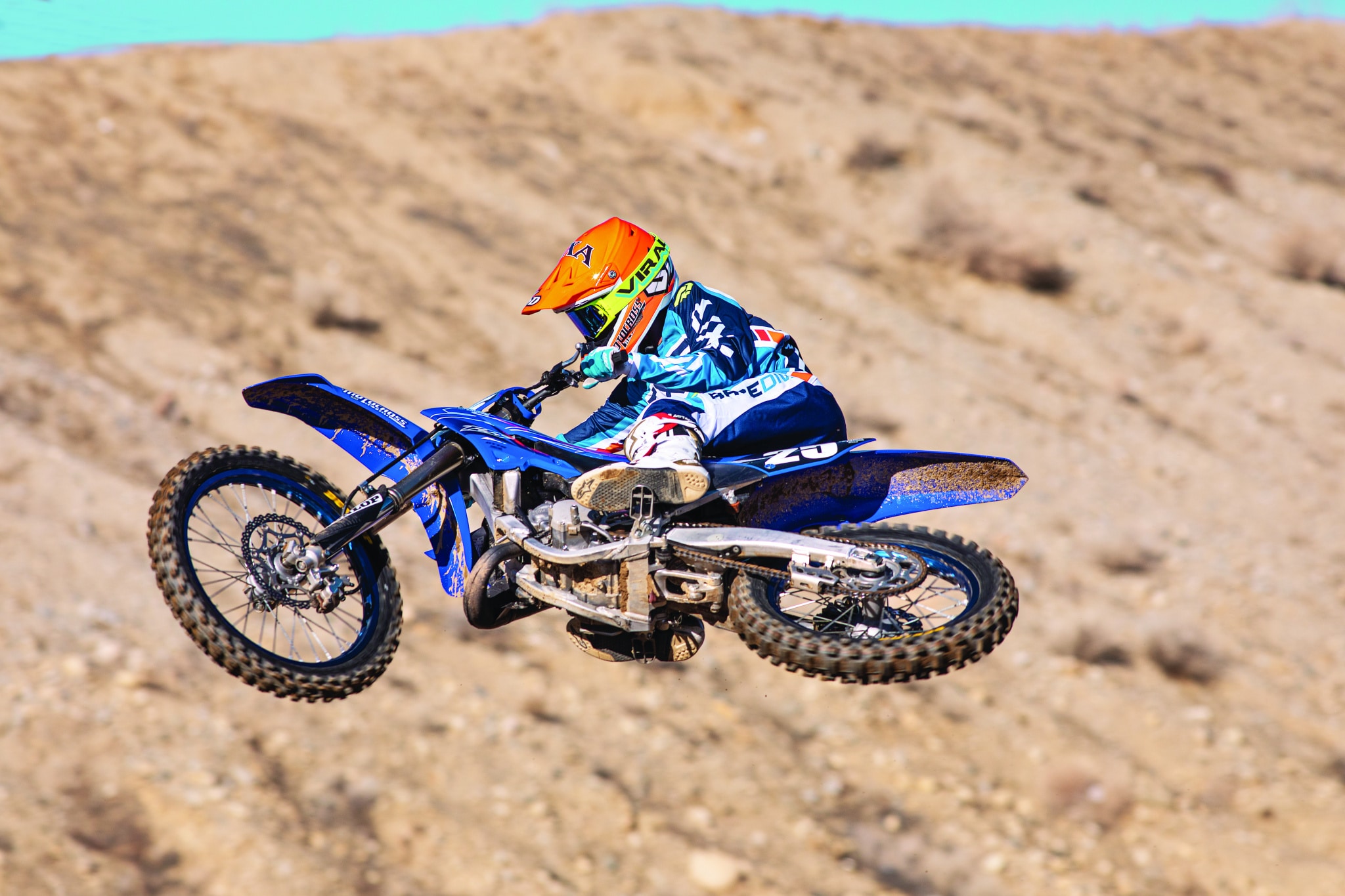
YAMAHA YZ125 VERSUS EVERYONE ELSE
The Yamaha used to be the easiest 125 to ride, but that isn’t the case anymore. Yamaha obviously shifted its target YZ125 demographic from young and light riders making the transition from minis into the big-bike ranks to a faster and heavier audience that already has four-stroke experience but is dropping down to the 125 for the two-stroke experience. The YZ125 lost the easy-to-ride quality it was known for when the boys in blue went searching for more power higher up the curve. On the dyno, the 2022 YZ125 is slower than the 2021 YZ125 off the crack of the throttle, as much as 1-1/2 horsepower off last year’s YZ125 at 6500 rpm. The 2022 YZ125 power kicks in at 7500 rpm and is 1 horsepower stronger than last year’s bike where it is ridden most, only losing out below 7500. The dyno numbers aren’t what we (or Yamaha) hoped for, but thankfully the power it does have is where it needs to be for 125 racing. We confess that we expected more power after waiting 16 years. More power would have given us a greater margin of error.
The Austrian bikes had stock jetting that worked great for us at sea level in Southern California, but the jetting on the new Yamaha YZ125 was ratty—on the track and on the dyno. We made it feel better by going from 160 to 162 on the main jet and down from 75 to 72 on the pilot jet. We also moved the clip on the needle from the second to the first line on the top to lean it out. Our jetting will not work for every temperature, humidity or elevation—so be prepared to juggle brass. The other big change we made was to add a tooth to the rear sprocket, going from a 13/48 to a 13/49 sprocket combination. This, along with crisper jetting, helped us get out of corners quicker.
To continue with the same theme as the engine, the YZ125 handling is also targeted towards a faster, heavier and more experienced rider than before. Just as the 2021 YZ125 engine was novice-friendly, last year’s suspension was soft and plush, which was great for novices and light riders as well. Now, the 2022 spring rates have been increased from 4.2 to 4.3 in the forks and 46 to 48 on the shock, and the valving has been made stiffer, too. Plus, the new subframe and seat create a flatter topography of the bike with a taller seat height.
2022 MXA 125 TWO-STROKE SHOOTOUT—125 BIKE OF THE YEAR
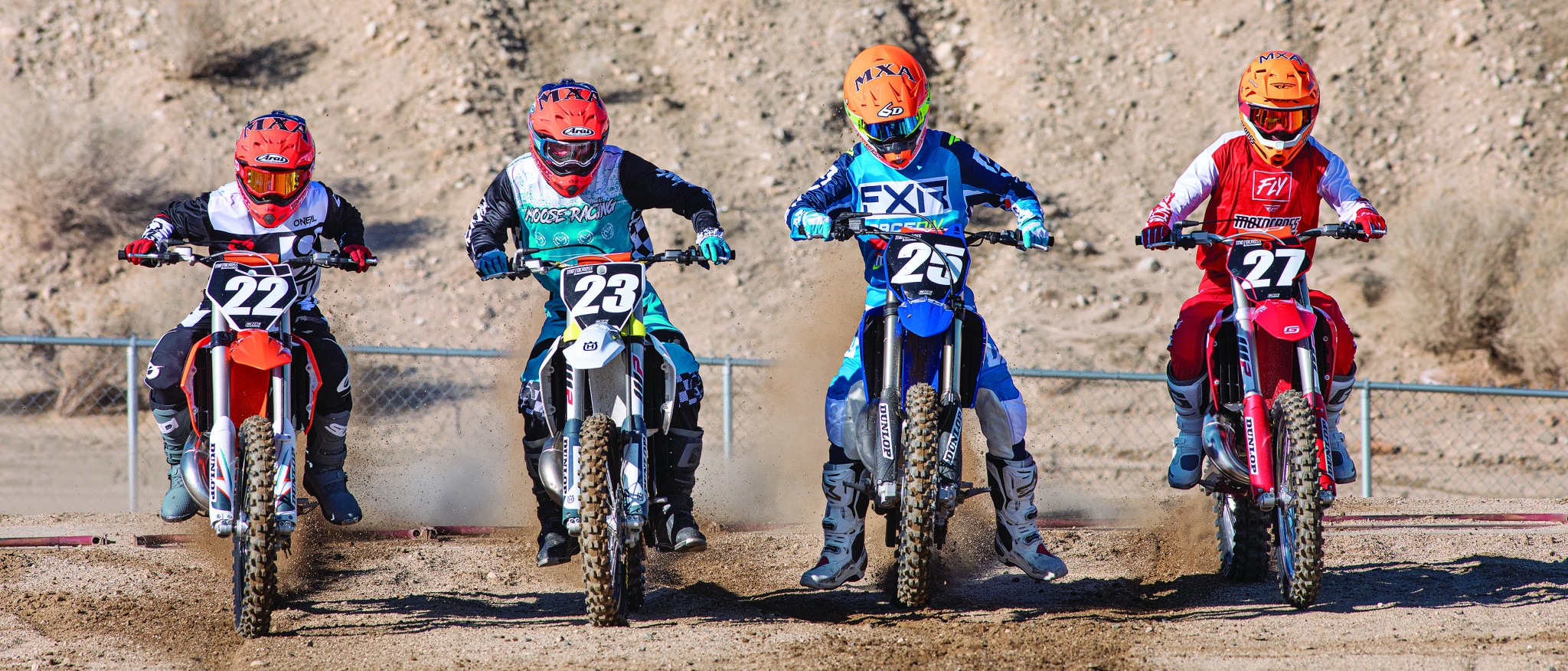 When it comes to winning races, scoring fast lap times and picking the 2022 MXA 125 Two-Stroke Bike of the Year, engine usability and power delivery play big roles. How come? Because all 125 two-strokes handle fairly well. At 194 pounds for the Austrian bikes and 199 pounds for the Yamaha, all of these bikes are lightweight and nimble. With all four engines producing less than 40 horsepower, these bikes aren’t pulling hard enough or going fast enough to have extremely adverse handling‚ thus they can all be made to do what the rider wants. But, in the end, the meat and potatoes of a good 125 is power.
When it comes to winning races, scoring fast lap times and picking the 2022 MXA 125 Two-Stroke Bike of the Year, engine usability and power delivery play big roles. How come? Because all 125 two-strokes handle fairly well. At 194 pounds for the Austrian bikes and 199 pounds for the Yamaha, all of these bikes are lightweight and nimble. With all four engines producing less than 40 horsepower, these bikes aren’t pulling hard enough or going fast enough to have extremely adverse handling‚ thus they can all be made to do what the rider wants. But, in the end, the meat and potatoes of a good 125 is power.
FIRST PLACE: KTM 125SX
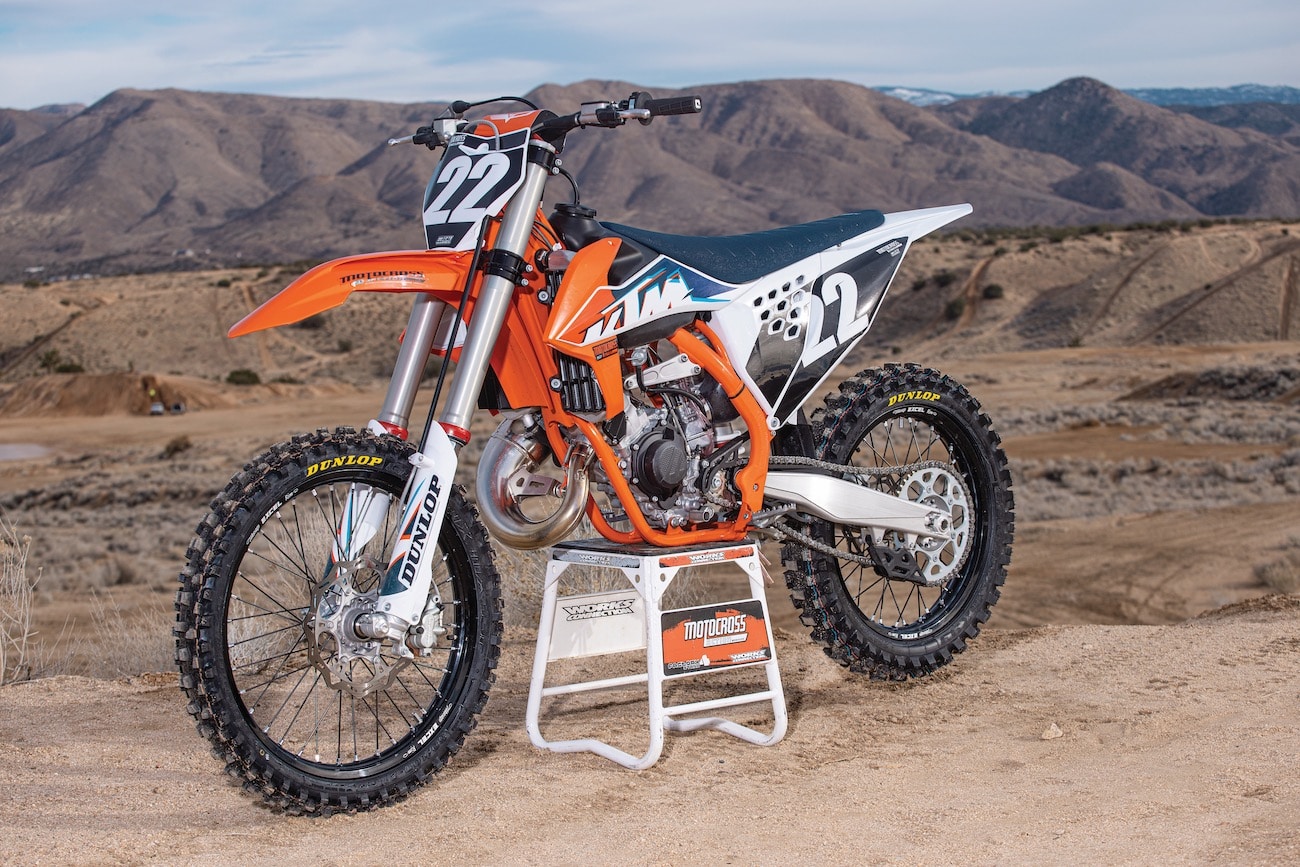 The KTM 125SX wins MXA’s 125 Two-Stroke Bike of the Year award because it is best suited for racers. With a 2-horsepower advantage over the Yamaha and a snappier throttle response than the Husky and GasGas, the KTM is ready to win races. Yes, if you spend $600 on the Yamaha, you might be able to get closer to the KTM, but then you could’ve just bought a KTM in the first place, because you’ll be back to square one when the KTM owner makes the same mods.
The KTM 125SX wins MXA’s 125 Two-Stroke Bike of the Year award because it is best suited for racers. With a 2-horsepower advantage over the Yamaha and a snappier throttle response than the Husky and GasGas, the KTM is ready to win races. Yes, if you spend $600 on the Yamaha, you might be able to get closer to the KTM, but then you could’ve just bought a KTM in the first place, because you’ll be back to square one when the KTM owner makes the same mods.
SECOND PLACE (TIE): GASGAS MC 125
 In 2021, we ranked the GasGas third, just behind the Husqvarna. After more testing, more lap time comparisons and more racing at events like the World Two-Stroke Championship, we determined that it wasn’t fair to position the GasGas behind the Husky in our 125 Shootout anymore, even though these bikes didn’t change. Even with the closed-off airbox, softer suspension and triple clamps that weren’t as precise, our experienced testers could go faster on the GasGas than the Husky, and we can only attribute that to the more efficient GasGas airbox shape.
In 2021, we ranked the GasGas third, just behind the Husqvarna. After more testing, more lap time comparisons and more racing at events like the World Two-Stroke Championship, we determined that it wasn’t fair to position the GasGas behind the Husky in our 125 Shootout anymore, even though these bikes didn’t change. Even with the closed-off airbox, softer suspension and triple clamps that weren’t as precise, our experienced testers could go faster on the GasGas than the Husky, and we can only attribute that to the more efficient GasGas airbox shape.
SECOND PLACE (TIE): HUSQVARNA TC125
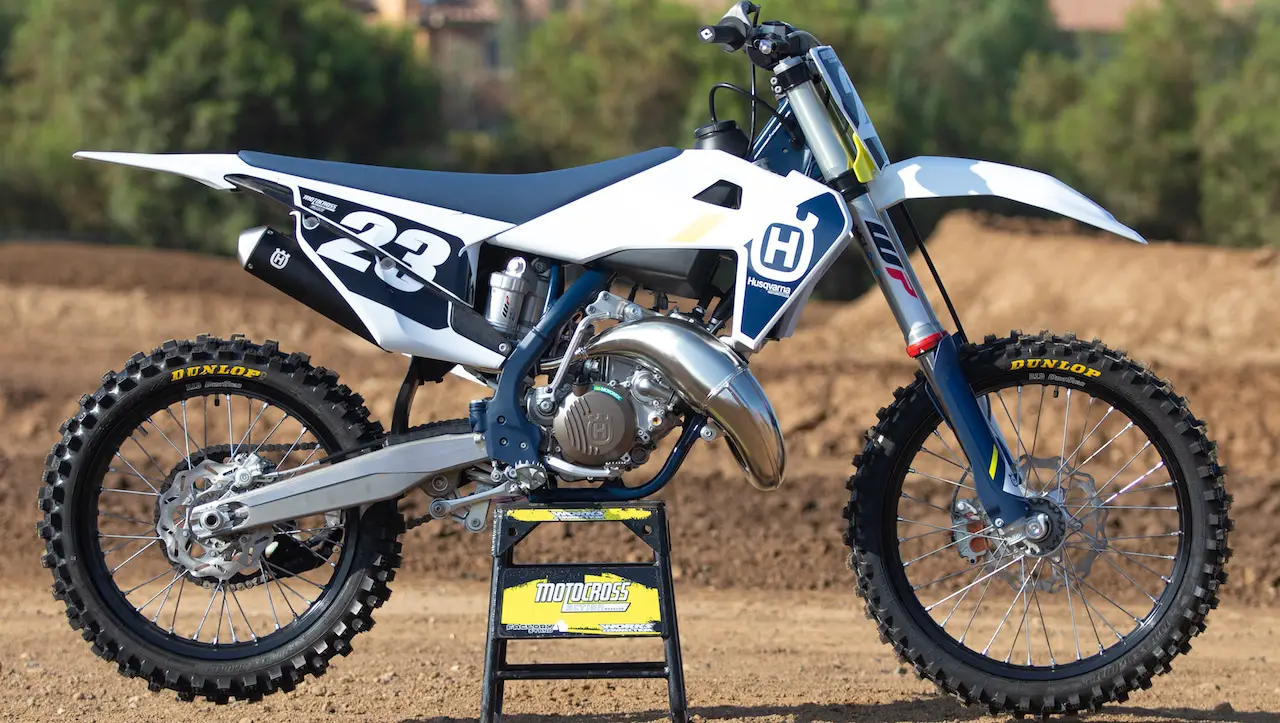 Although the Husqvarna TC125 has to share second place with the GasGas, all is not lost. If we were doing a shootout for “The Best 125 Play Bike‚“ “The Best 125 for Novices” or “The Best-Handling 125,” this bike would easily win. Our novice-level test riders went faster on the Husky because of its smooth, easy-to-manage power and its lowered suspension. On the contrary, our pro test riders were slower on the Husqvarna than they were on the Yamaha, KTM and GasGas because of the same smooth but slow throttle response.
Although the Husqvarna TC125 has to share second place with the GasGas, all is not lost. If we were doing a shootout for “The Best 125 Play Bike‚“ “The Best 125 for Novices” or “The Best-Handling 125,” this bike would easily win. Our novice-level test riders went faster on the Husky because of its smooth, easy-to-manage power and its lowered suspension. On the contrary, our pro test riders were slower on the Husqvarna than they were on the Yamaha, KTM and GasGas because of the same smooth but slow throttle response.
FOURTH PLACE: YAMAHA YZ125
 The new YZ125 is better than its previous version for fast racers but not good enough to jump past the Austrian offerings. It’s also worse for riders who are less experienced with shifting, clutching and maintaining a high rpm. Sadly, the engine didn’t live up to our expectations, but at least it is a step closer to the KTM. After 16 years of the same engine from Yamaha, we expected the new YZ125 to easily catch up to the KTM, but we underestimated the steps KTM has taken to advance their breed. Now, just after Yamaha took a step closer in 2022, KTM and Husqvarna are preparing to release all-new two-strokes in 2023 to match the new 2022 Factory Edition four-strokes that have just come out.
The new YZ125 is better than its previous version for fast racers but not good enough to jump past the Austrian offerings. It’s also worse for riders who are less experienced with shifting, clutching and maintaining a high rpm. Sadly, the engine didn’t live up to our expectations, but at least it is a step closer to the KTM. After 16 years of the same engine from Yamaha, we expected the new YZ125 to easily catch up to the KTM, but we underestimated the steps KTM has taken to advance their breed. Now, just after Yamaha took a step closer in 2022, KTM and Husqvarna are preparing to release all-new two-strokes in 2023 to match the new 2022 Factory Edition four-strokes that have just come out.



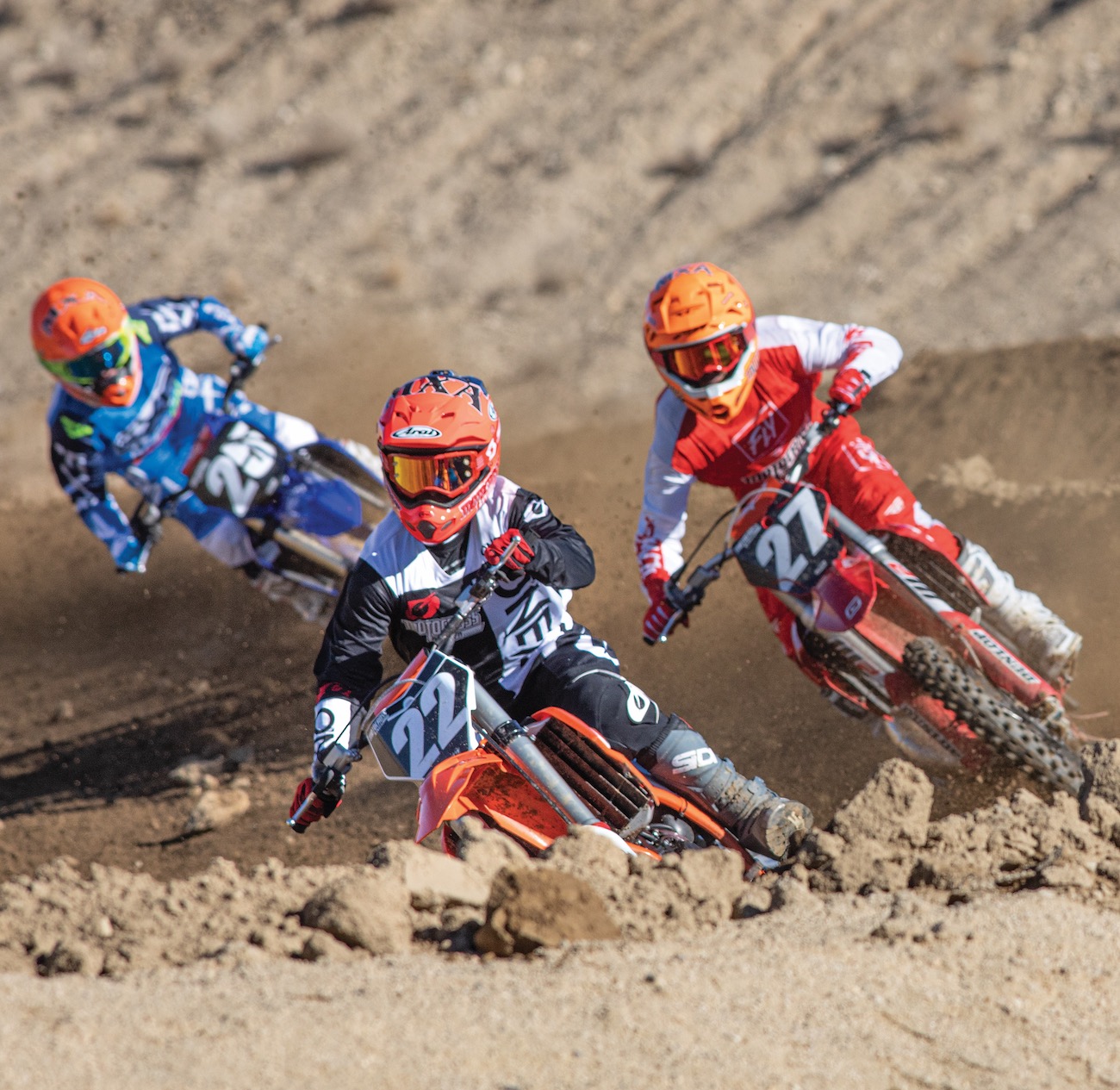




Comments are closed.